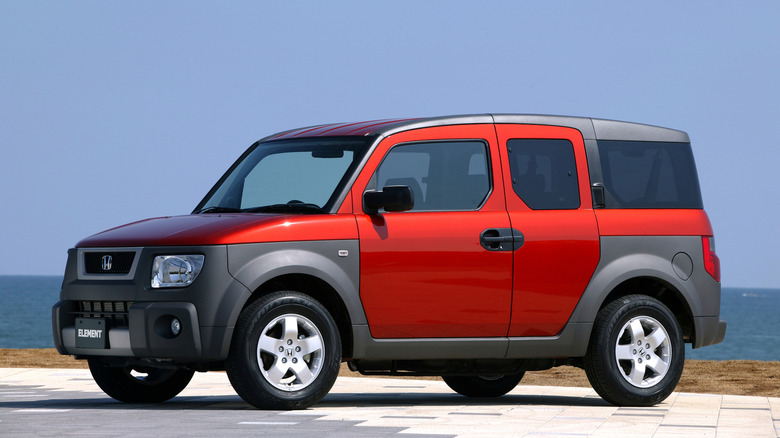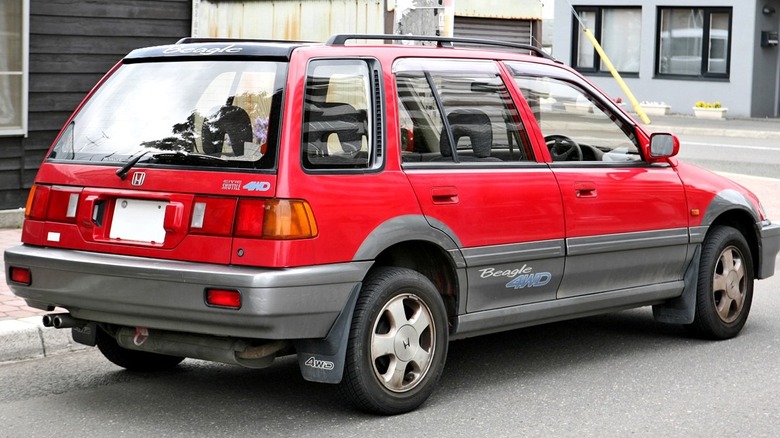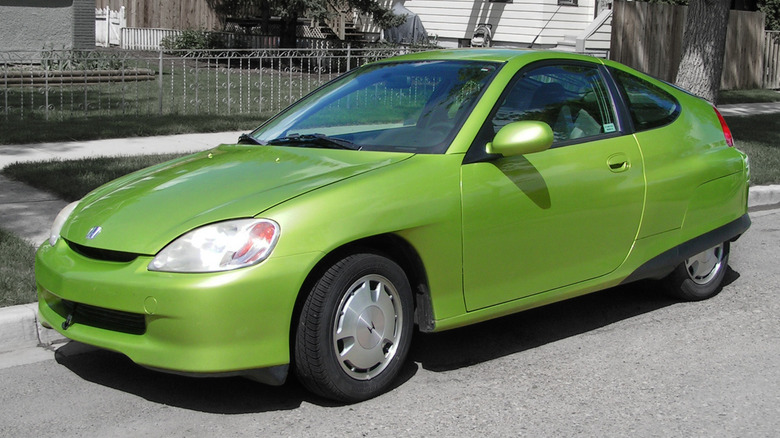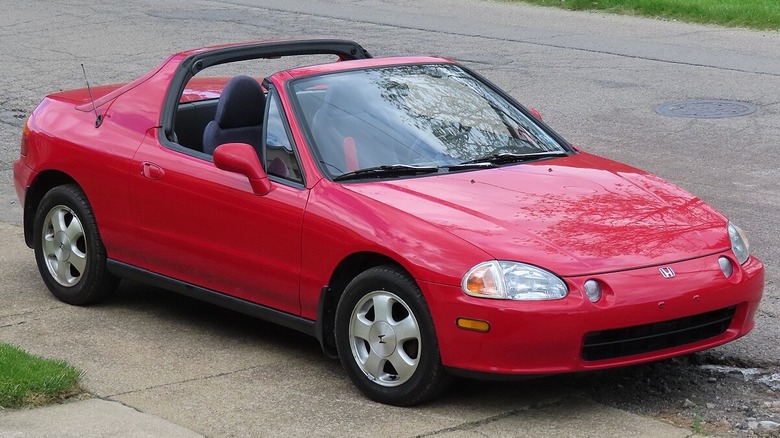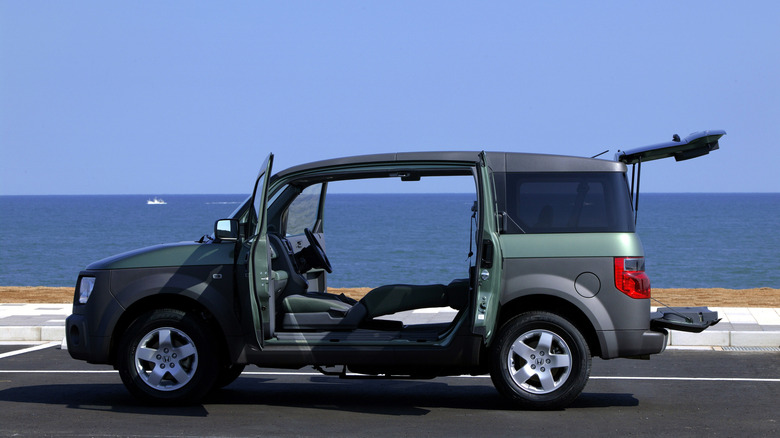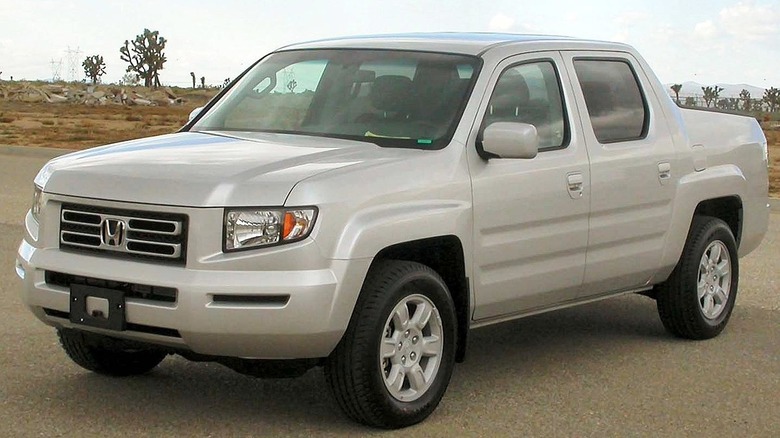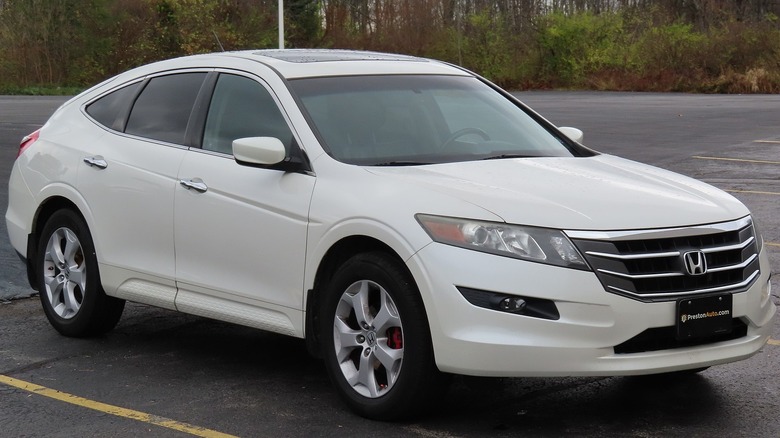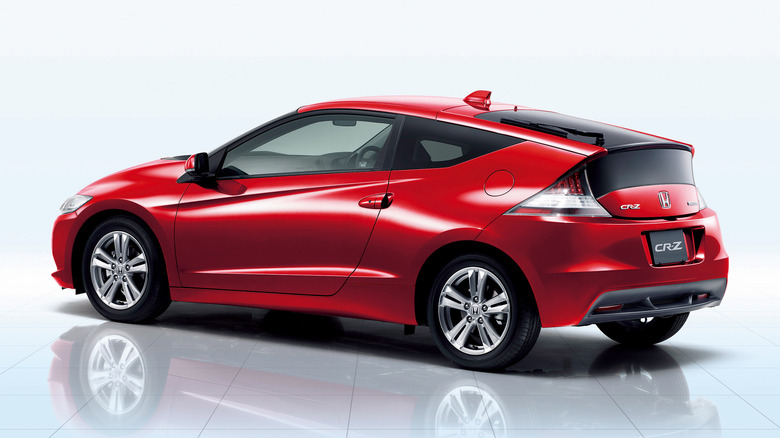8 Of The Weirdest Hondas Ever Designed
Honda has certainly earned its place as a mainstream car manufacturer. The Civic alone has sold over 27 million units worldwide since its introduction in 1972. Newer models have done just as well; The CR-V is one of the world's best-selling compact SUVs, with over 10 million sold since its introduction in 1995. Indeed, a list of the top-selling Honda cars of all time reveals several excellent models with appeal across wide demographics.
However, Honda hasn't been afraid to take risks by building models with more niche appeal. This might be attributed to the innovative culture fostered by the company's founder, Soichiro Honda. He started his career as an apprentice with an auto repair service called Art Shokai before Japan had an indigenous auto manufacturing industry. As the manager of Art Shokai's branch in Hamamatsu, he became known as the Edison of Hamamatsu. After World War II, with Japan in ruins, he attached surplus generator motors to bicycles and sold them. This clever business eventually became the genesis of the Honda Motor Company.
Honda brought the same innovative spirit to motorcycle and car racing efforts and eventually to building cars for public purchase. In 1967, the company debuted the Honda N360 kei car. Soon after that came the Civic and worldwide mainstream success. But true to the visionary attitude of its founder, the Honda Motor Company has always been willing to take chances. Some of its cars have taken on forms that could be considered offbeat, niche-oriented, and yes, even weird. Although, as we'll see, what is weird in one generation sometimes becomes mainstream down the line.
1980s Honda 4x4 Civic Wagon
The Honda 4x4 Civic Wagon is a great example of Honda's vision being ahead of its time. This awkward Civic wagon/hatchback was an oddity in its day, but it foreshadowed compact SUVs like the CR-V. By the way, if you're wondering what CR-V stands for, Honda lore has it that it means Comfortable Runabout Vehicle. This is a good description of its 4x4 Civic Wagon predecessor, which was based on the Civic platform and offered all the excellent driving characteristics that made the Civic a bestseller, along with extra passenger and cargo space offered by its high roofline.
The 4x4 Civic Wagon was so different for its time that even Honda didn't seem entirely sure what to call it. Depending on what year and what market you were shopping in, it might also be called the Wagovan, the Civic Shuttle, or the Beagle. The Dodge Colt Vista and the Toyota Tercel 4WD were among the very few similar cars at the time. Like the 4x4 Civic Wagon, they were tough to peg in any one category since SUVs, and particularly car-based crossover SUVs, didn't start to become popular until the mid-1990s.
In 1987, Honda introduced a new 4x4 system that was fairly sophisticated for its time. Honda called it Realtime 4WD, and rather than being manually activated like the previous system, it was automatic. When the front wheels began to lose grip, the system redirected power to the rear wheels. Even today, Honda still uses a variation of both the technology and the terminology, referring to its current system as Real Time AWD. Thus, the little Wagovan became the ancestor to one of Honda's most successful vehicles.
1980s Honda Civic CRX
Calling the Honda Civic CRX weird may rankle some readers of a certain age who fondly remember what a fantastic little car it was. Nonetheless, it was hard to categorize and looked unlike anything else on the road. Today, we'd probably characterize it as a hot hatch and compare it to cars like the Volkswagen GTI, but the GTI was based on a practical Golf hatchback with a rear seat and a decent-sized cargo area. The CRX, by comparison, was a two-seater with a sloping profile that didn't leave much room under the hatch for cargo. It was a pure sporty runabout, and it was truly one of a kind.
Technically, the CRX was a Kammback design, which refers to a car with a sloping back end that stops with an abrupt vertical drop. This is a highly aerodynamic form factor, and it reflects the fact that the CRX was intended to be economical as well as fun to drive. It was never known for big horsepower numbers, with its debut model in 1984 topping out at 76 hp, but its light weight made it an excellent handler. Plus, it had an EPA highway rating of 67 mpg — the highest fuel economy rating in America that year. This combination of fun and frugality helped the CRX win Motor Trend's Import Car of the Year award.
These were just some of the coolest features of the CRX. For instance, in 1985, the CRX Si got electronic fuel injection, boosting the top horsepower from 76 to 91. That still sounds underwhelming by modern standards, but keep in mind that this tiny car barely weighed over 1,800 pounds. This gave it a 9.1-second zero-to-60 time, which was not bad for an economical car in the '80s.
1999 Honda Insight (first generation)
Honda introduced the Insight hybrid in 2000, and the original Insight has a cult following today. Honda was the first mainstream carmaker to market a hybrid in the United States, but in those days, hybrids required compromises inside and out, resulting in arguably the strangest-looking production Honda ever built. It was a tiny two-seater weighing just a bit over 2,000 pounds, but its styling truly set it apart. For maximum aerodynamics, it featured a teardrop shape that somehow still looks futuristic even today. The rear wheel arches are covered to smooth airflow even more. Changing a tire with those skirts in the way would have given reality to the word compromise.
Nevertheless, in combination with the car's hybrid drivetrain, the styling did its job. The EPA rated the Insight at 61 mpg in the city and 70 mpg on the highway. Given that the Toyota Prius hybrid didn't arrive in the USA. until 2001, that left the Insight all alone as the mileage champ in America. The Insight achieved its killer fuel efficiency numbers with Honda's Integrated Motor Assist system, which used a 10-kilowatt electric motor between the three-cylinder engine and the transmission to boost the drivetrain's output. Total horsepower came out to 73 with 91 lb-ft of torque. These weren't autobahn-burning numbers, but keep the Insight's one-ton weight in mind. The car could do 0-60 in a reasonable 10.6 seconds. An idle stop system and regenerative braking boosted fuel economy even more.
The Insight wasn't an economy-car penalty box on the inside. It offered power windows and remote keyless entry as standard features. The driving experience was comfortable and normal enough to forget how strange the Insight looked on the outside.
1993 to 1997 Honda Del Sol
The quirky and exceedingly tiny targa-topped Honda Del Sol was a bit of a bolt from the blue when it debuted in the U.S. in 1993, but it has aged into something of a classic. Honda actually intended it as a follow-up model to the CRX, and referred to it as the CRX Del Sol in some markets, although its odd, not-quite-a-roadster appearance made some enthusiasts wary. Yet appreciation for the car has grown, and we ranked it one of the best-looking Hondas of all time. Plus, after all, it is a Civic under the skin, so it brings some of the best qualities of Honda's beloved compact car.
Outside of the U.S., the Del Sol got a trick mechanical roof system in which the trunk lid would raise and latch onto the roof, and then pull the roof under the trunk lid and lower it out of sight. Drivers in the U.S. had to make do with manually removing and stowing the roof panel. The roof developed a reputation for leaking, which was a bit of a black mark for a manufacturer with a reputation for perfection.
The Del Sol also didn't develop as great a reputation for sporty driving as its CRX ancestor did. Its front-wheel-drive layout left it at a disadvantage compared to its main competitor, the rear-wheel-drive Mazda Miata. For this and other reasons, Honda discontinued the Del Sol after the 1997 model year in the U.S. and after 1998 in other markets. Chalk it up as a brave but failed experiment for Honda.
2003 to 2011 Honda Element
The Honda Element's offbeat, boxy appearance and controversial black plastic body panels didn't give a clue about what an extremely versatile interior it had. To describe this SUV as polarizing is an understatement. Many people hate the Honda Element. Yet others adore it for its utility and its surprisingly fun handling. On the utility front, its rear seats offered three configurations for those looking for cargo or camping space. They could recline, fold flat against the side walls of the cabin, or be removed entirely. With the seats flat against the walls, there was room for everything from mountain bikes to sleeping bags on the van-like flat rear floor.
That flat floor, believe it or not, is a clue to the Element's sprightly handling. The Element was based on the Honda CR-V crossover SUV but with substantial changes to its structure. One of those modifications was a floor that was about an inch lower, which helped to lower the Element's center of gravity despite a roofline over seven inches higher than a CR-V. This translated into better tossability in the curves and a noticeably higher skidpad measurement of 0.78 compared to the contemporary CR-V's 0.72. The Element also did away with B-pillars to enable its front and rear doors to open clamshell style, offering even more options for loading cargo.
In its debut year of 2003, the Element sported a 160-horsepower, 2.4-liter four-banger with its power routed through either a five-speed manual or a four-speed automatic. By its last year in 2011, the engine had reached 166 horsepower. It also lost some of the black plastic body panels in favor of traditional metal pieces, making it slightly more conventional-looking, but not enough to overcome the Element's weird image.
2006 to 2014 Honda Ridgeline (first generation)
Contrary to what you might expect, pickup truck genes lurk deep within Honda's automotive DNA. One of its very first four-wheeled vehicles was the T360 pickup that debuted in 1963. Many years later, those genes expressed themselves again in the 2006 Ridgeline, which was a solid effort for what it was, which was a unibody pickup truck. Its rear bed profile that sloped down from the C-pillar to the tailgate could charitably be described as polarizing, and being a unibody vehicle could compromise some of the functions of a pickup truck, such as towing.
Honda was aware of that latter problem and modified the Ridgeline's chassis, which was based on the Pilot SUV, to make it more rugged. These modifications included a beefed-up suspension and extra structural crossmembers under the bed, which gave the Ridgeline greater rigidity than the Pilot. As a result, the new pickup could haul 1,500 pounds and tow 5,000 pounds, all while offering car-like handling and the comfort that drivers were used to from Honda's sedans. Plus, of course, Ridgeline drivers enjoyed Honda's legendary dependability, making it one of the most reliable pickup trucks of all time.
Under the hood, the Ridgeline offered a 3.5-liter, 255-horsepower V6 that generated 252 lb-ft of torque. This engine featured Honda's VTEC variable valve timing technology and sent its power to all four wheels through a five-speed automatic. First gear offered a center differential lock function for driving in the rough stuff. Clever features included a trunk below the bed and a tailgate that opened either in traditional fashion or off to the side to make accessing the hidden trunk easier. A 2016 redesign would give the Ridgeline a more conventional appearance, but under the skin, it still carried on Honda's unique design philosophy.
2010 to 2015 Honda Accord Crosstour
It's not that the Honda Accord Crosstour was a bad car — it was decent. But what was it, exactly, a wagon, a hatchback, or an SUV? A decade after Honda ceased to build it, that question is still hard to answer. In the automotive world, if a car is going to be weird and hard to define, it had better be great, and not just decent. The Crosstour falls into an uncanny valley of strangeness that makes people uncomfortable, and as a result, some consider it one of the most hated Honda models ever made.
Part of the problem lies in how it doesn't do any one thing well. A Motor Trend reviewer criticized it for "driving dynamics that aren't as good as a regular sedan, and limited cargo capacity thanks to the sloping roofline." The reviewer also felt that the 271-horsepower V6 wasn't up to snuff, although he conceded that the Crosstour drove well in snow.
Its prowess in snow may have been due to available all-wheel drive. The drivetrain had to pull a vehicle that was bigger and heavier than a regular Accord, yet it achieved just a bit less fuel efficiency than its sedan counterparts. Its zero-to-60 time was a decent 7.2 seconds. The driving experience was livelier and more car-like than most SUVs, even if it wasn't quite as good as a sedan's. Rear visibility was compromised by the crossbar on the hatchback and very long, sloping D-pillars. In this, as in so many other ways, the Crosstour was a decent car compromised by its weirdness.
2011 to 2016 Honda CR-Z
Honda's intentions were good with the CR-Z. It wanted to recapture the magic of the CRX in a hybrid. Alas, the execution of the idea left something to be desired. Its styling certainly called back to the CRX's late-1980s glory years with its wedge-shaped, high-backed profile complete with a hatchback with its glass split by a crossbar like the second-generation CRX. Of course, that split rear hatch window was never great for rearward visibility in either car — one of the drawbacks of being weird, apparently. Also, like the CRX, the CR-Z was a two-seater.
The 1980s CRX had been a two-seater to squeeze excellent performance from a light and economical package. The CR-Z sought to do the same, in theory. But this is where it fell flat. On paper, it offered more power from its 113-horsepower hybrid drivetrain, but it was also about 600 pounds heavier than the CRX. The power-to-weight ratio just wasn't equal to that of its Reagan-era ancestor. Its ride and handling were decent, though, with a commendable 0.85 g skidpad grip. The cargo area was reasonably big for such a small car, too.
By 2015, a supercharger kit could be installed by Honda dealers, which boosted horsepower up to 197. However, it added up to $15,000 to the price. This brings up a point made by a Car and Driver review about the original 2011 model. The CR-Z cost the same as a five-passenger Insight hybrid sedan, and a lot more than a faster and nearly as efficient Honda Fit. All of this helps to explain what happened to the CR-Z after the 2016 model year, when Honda discontinued it for lack of sales.
